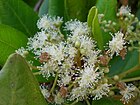Note: This is a project under development. The articles on this wiki are just being initiated and broadly incomplete. You can Help creating new pages.
Difference between revisions of "Pimenta dioica"
| (2 intermediate revisions by the same user not shown) | |||
| Line 1: | Line 1: | ||
[[File:Pimenta dioica-IMG 3442.jpg|thumb|right|'''Pimenta dioica''']] | [[File:Pimenta dioica-IMG 3442.jpg|thumb|right|'''Pimenta dioica''']] | ||
| − | '''Pimenta dioica''' is | + | '''Pimenta dioica''' It is a midcanopy tree native to the Greater Antilles, southern Mexico, and Central America, now cultivated in many warm parts of the world. |
==Uses== | ==Uses== | ||
{{Uses|Menstrual cramps}}, {{Uses|Abdominal pain in Caribbean culture}}, {{Uses|Cardiovascular effects}}. | {{Uses|Menstrual cramps}}, {{Uses|Abdominal pain in Caribbean culture}}, {{Uses|Cardiovascular effects}}. | ||
| Line 8: | Line 8: | ||
==Chemical Composition== | ==Chemical Composition== | ||
| − | The leaf oil of Pimenta dioica L. of Cuban origin has been analyzed by a combination of capillary gas chromatography and GC/MS. The oil contained more than fifty components, of which more than forty have been identified. The main constituent found was eugenol | + | The leaf oil of Pimenta dioica L. of Cuban origin has been analyzed by a combination of capillary gas chromatography and GC/MS. The oil contained more than fifty components, of which more than forty have been identified. The main constituent found was eugenol.<ref name="chemical composition"/> |
| − | <ref name="chemical composition"/> | ||
==Common names== | ==Common names== | ||
| Line 52: | Line 51: | ||
==How to plant/cultivate== | ==How to plant/cultivate== | ||
| − | A plant of the moist to wet lowland tropics, growing best at elevations below 330 metres but able to be grown up to 1,500 metres. | + | A plant of the moist to wet lowland tropics, growing best at elevations below 330 metres but able to be grown up to 1,500 metres.<ref name="How to plant/cultivate"/> |
| − | <ref name="How to plant/cultivate"/> | ||
==Commonly seen growing in areas== | ==Commonly seen growing in areas== | ||
| Line 76: | Line 74: | ||
==External Links== | ==External Links== | ||
| − | * [http://hbs.bishopmuseum.org/pdf/op41-19-58.pdf Pimenta dioica] | + | * [http://hbs.bishopmuseum.org/pdf/op41-19-58.pdf Pimenta dioica on bishopmuseum.org] |
[[Category:Herbs]] | [[Category:Herbs]] | ||
[[Category:Myrtaceae]] | [[Category:Myrtaceae]] | ||
Latest revision as of 13:11, 2 July 2020
Pimenta dioica It is a midcanopy tree native to the Greater Antilles, southern Mexico, and Central America, now cultivated in many warm parts of the world.
Contents
- 1 Uses
- 2 Parts Used
- 3 Chemical Composition
- 4 Common names
- 5 Properties
- 6 Habit
- 7 Identification
- 8 List of Ayurvedic medicine in which the herb is used
- 9 Where to get the saplings
- 10 Mode of Propagation
- 11 How to plant/cultivate
- 12 Commonly seen growing in areas
- 13 Photo Gallery
- 14 References
- 15 External Links
Uses
Menstrual cramps, Abdominal pain in Caribbean culture, Cardiovascular effects.
Parts Used
Chemical Composition
The leaf oil of Pimenta dioica L. of Cuban origin has been analyzed by a combination of capillary gas chromatography and GC/MS. The oil contained more than fifty components, of which more than forty have been identified. The main constituent found was eugenol.[1]
Common names
| Language | Common name |
|---|---|
| Kannada | |
| Hindi | |
| Malayalam | |
| Tamil | |
| Telugu | |
| Marathi | NA |
| Gujarathi | NA |
| Punjabi | NA |
| Kashmiri | NA |
| Sanskrit | |
| English | Allspice |
Properties
Reference: Dravya - Substance, Rasa - Taste, Guna - Qualities, Veerya - Potency, Vipaka - Post-digesion effect, Karma - Pharmacological activity, Prabhava - Therepeutics.
Dravya
Rasa
Guna
Veerya
Vipaka
Karma
Prabhava
Habit
Identification
Leaf
| Kind | Shape | Feature |
|---|---|---|
| Simple | Round in outline | Leaves are 6-15 cm long, 3-6 cm wide and aromatic when crushed. They are dark green on the upper surface and lighter green beneath. |
Flower
| Type | Size | Color and composition | Stamen | More information |
|---|---|---|---|---|
| Bisexual | White | Flower branches 5-15 cm long. |
Fruit
| Type | Size | Mass | Appearance | Seeds | More information |
|---|---|---|---|---|---|
| Simple Fruit | Round | 4-6 mm in diameter | Deep purple to black | {{{6}}} |
Other features
List of Ayurvedic medicine in which the herb is used
Where to get the saplings
Mode of Propagation
How to plant/cultivate
A plant of the moist to wet lowland tropics, growing best at elevations below 330 metres but able to be grown up to 1,500 metres.[3]
Commonly seen growing in areas
Photo Gallery
References
External Links
- Ayurvedic Herbs known to be helpful to treat Menstrual cramps
- Ayurvedic Herbs known to be helpful to treat Abdominal pain in Caribbean culture
- Ayurvedic Herbs known to be helpful to treat Cardiovascular effects
- Herbs with Flower used in medicine
- Herbs with Leaves used in medicine
- Herbs with common name in English
- Habit - Tree
- Index of Plants which can be propagated by Seeds
- Herbs that are commonly seen in the region of Tropical area
- Herbs
- Myrtaceae



